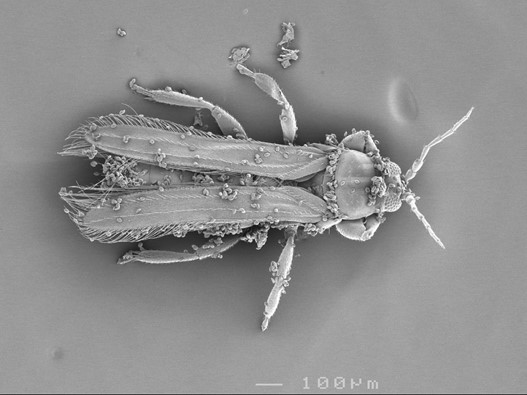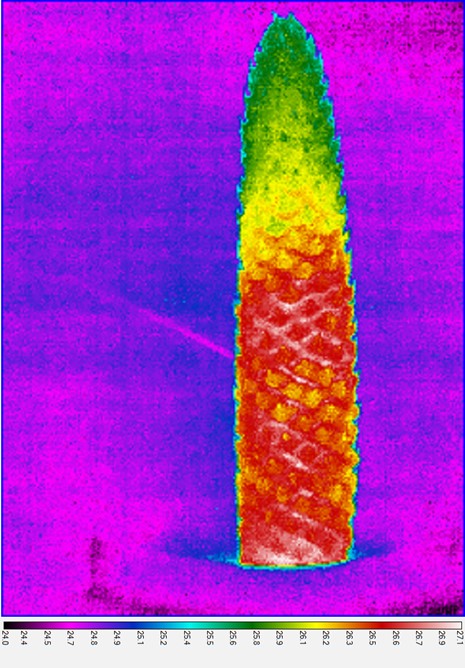Cycads are one of the most ancient group of gymnosperm (non-flowering) plants on Earth – evolving well before the dinosaurs. In SEQ, most cycads are species of Macrozamia and it was initially thought that they were pollinated by the wind. However, long-term research has shown that they are pollinated only by thrips or weevils. It has also been found that individual species of Macrozamia produce unique compounds that attract specific pollinators. Some of these compounds are not known anywhere else in the natural world.
The Macrozamias that are pollinated only by thrips are pollinated by thrips from the Genus Cycadothrips. Some Macrozamia are pollinated only by thrips and some are pollinated by both thrips and weevils. The image here clearly shows the pollen attached to a Cycadothrips. The fine hairs covering this thrip are said to aid in the attachment of cycad pollen.

Macrozamias also have another trait that is rare in the plant world – they can produce their own heat, also called thermogenesis. Thermogenesis is known as the production of heat within an organism and while it occurs in all warm-blooded animals it is rare in the plant world. It is said that most plants use this trait to assist in the production or dispersal of chemicals to attract pollinators.
Adult thrips and their larvae only feed on pollen from the male cones. These cones can heat up during the day and the thrips will leave the male cone when it gets too hot. Incredibly, the cones sometimes will heat up to 15⁰C above the ambient temperature. The heat produced from one cone could produce enough watts to power a small computer monitor. The female cones also have a chemical signature, but it is weaker than the males. Female cones attract the heat-evicted adult thrips from the male cone, incidentally carrying pollen, and therefore resulting in pollination of the cycad. It doesn’t take too many thrips to pollinate the female cones.
The Macrozamias found in the D’Aguilar Range west of Brisbane, produce a chemical signature that lead researcher Dr Irene Terry from the University of Utah describes as a hoppy beer smell, similar to the smell emanating from the XXXX Brewery on Milton Road in Brisbane. Whereas the Macrozamias found at Mt Archer in Rockhampton produce a smell like aniseed. Dr Terry has been coming to Queensland since 2001 researching Macrozamias first upon the invitation of Dr Laurence Mound from CSIRO and is now working with staff from the University of Queensland and has in the past worked with staff from the Queensland Herbarium.

Macrozamias are found in small populations across Queensland and there are currently 20 named species, of which 13 are listed as threatened (six are Endangered, six are Vulnerable and one is Near Threatened). The threats to both the Macrozamia and their obligate pollinators are land clearing, unplanned hot wildfires, inappropriate fire frequencies, illegal harvesting and drought. It could be said that an unplanned hot fire could impact small populations of Macrozamia and thereby impact their pollinator species and threaten a locally significant population. It is therefore important to protect not only the Macrozamia plants but also the mutualism species – the thrips and weevils.
There is still much to learn about the thrips and their mutualism with Macrozamia. Researchers are still yet to understand their life cycle in full as it is unknown where the thrips go to pupate. It is proposed they may pupate deep within the surrounding soil.
Populations of Macrozamia in SEQ include the Endangered Macrozamia pauli-guilielmi from Tin Can Bay, Macrozamia douglasii from the Fraser Coast, Macrozamia macleayi found in wetter forests of Brisbane and central Queensland, Macrozamia lucida found commonly from the Gold to Sunshine Coasts and the Near Threatened Macrozamia longispina found west of Gympie.
I am glad that I happened to meet Dr Terry and one of her colleagues Desley Tree (whom I knew) while walking my dog. Upon hearing of Dr Terry’s research, I thought it would be interesting to share it with the Land for Wildlife community.
Article by Craig Welden
Land for Wildlife Officer
Logan City Council
References & Further Reading
Atlas of Living Australia - http://www.ala.org.au
Leiper G, Glazebrook J & Cox D (2022) Mangroves to Mountains. Third Edition. Logan River Branch, Native Plants Qld.
Mound L & Terry I (2001) Thrips pollination of the central Australian cycad, Macrozamia macdonnellii (Cycadales). International Journal of Plant Sciences, 162, 147-154.
Terry LI (2001) Thrips and weevils as dual, specialist pollinators of the Australian cycad Macrozamia communis (Zamiaceae). International Journal of Plant Sciences,162, 1293-1305.
Terry I, et. al. (2004) Association of cone thermogenesis and volatiles with pollinator specificity in Macrozamia cycads. Plant Systematics and Evolution, 243, 233-247.
Terry I, Walter G, Moore C, Forster P & Donaldson J (2005) Pollination of Australian Macrozamia cycads. American Journal of Botany, 92, 931-940.
Terry I, Forster P, Roemer R, Machin P & Moore C (2008) Demographics, pollination syndrome and conservation status of Macrozamia platyrhachis. Australian Journal of Botany, 56, 321-332.
Terry I, Moore C, Roemer R & Walter G (2021) Unique chemistry associated with diversification in a tightly coupled cycad-thrips obligate pollination mutualism. Phytochemistry,186, 1-19.
